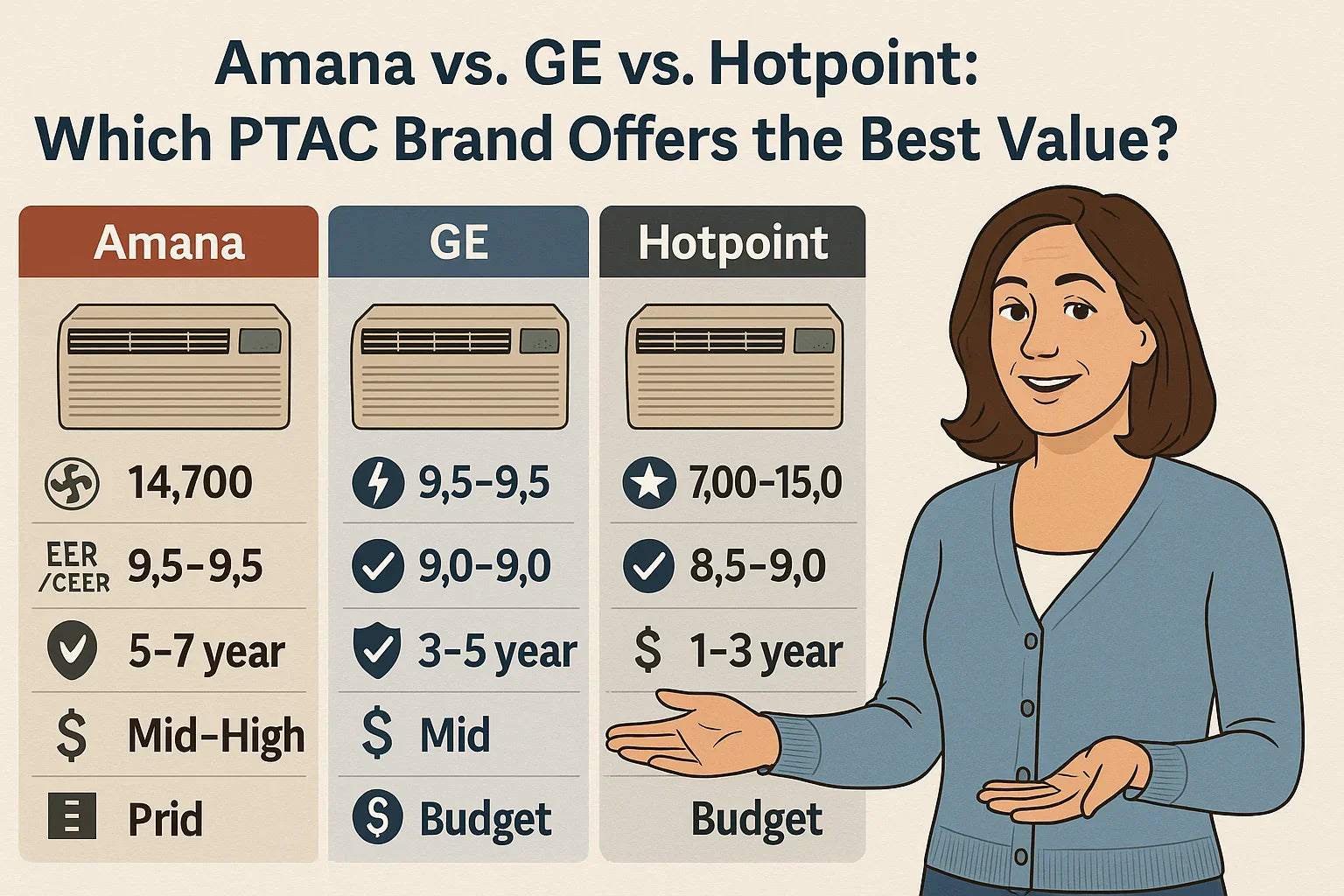When it comes to choosing a PTAC (Packaged Terminal Air Conditioner) for your apartment, studio, or rental property, the options can feel overwhelming. Three of the most popular brands are Amana, GE, and Hotpoint, each offering different features, efficiency ratings, and price points.
Amana Distinctions Model 14,700 BTU PTAC Unit with 3.5 kW Electric Heat
As a homeowner, I wanted a unit that would provide reliable heating and cooling, save energy, and fit within my budget. In this guide, I’ll walk you through the key differences between these brands, discuss their real-world performance, and help you decide which PTAC offers the best value for your needs.
🏠 1. Why Brand Choice Matters for PTAC Units
Choosing the right PTAC brand affects not just comfort, but also energy efficiency, long-term reliability, and cost of ownership. Here’s why:
-
Energy Efficiency: Higher efficiency means lower electricity bills over the life of the unit.
-
Reliability: Some brands have proven durability and fewer repair issues.
-
Warranty and Support: Length and coverage can save money if something goes wrong.
-
Installation and Maintenance: Some units are more DIY-friendly than others.
Samantha’s Tip: “I learned that looking at upfront price alone isn’t enough. Long-term energy savings and reliability are often more valuable than a cheaper initial purchase.”
⚡ 2. Amana PTAC Units
Amana is known for its reliable, high-performance PTACs, including the Distinctions 14,700 BTU model.
Key Features:
-
Cooling/Heating: Electric heat options and efficient cooling for small to medium apartments.
-
Efficiency: EER ratings around 9.5+, CEER ratings also high.
-
ENERGY STAR certified: Eligible for rebates and energy credits.
-
Warranty: Typically 5–7 years, depending on model.
-
Maintenance: Easy filter access, simple coil cleaning, and user-friendly drain system.
Pros:
-
Long-lasting, durable performance.
-
Energy-efficient operation reduces monthly costs.
-
Reliable support and warranty coverage.
Cons:
-
Slightly higher upfront cost compared to GE or Hotpoint.
-
Some models heavier and less portable than competitors.
Real-World Use:
-
Ideal for small to medium-sized apartments, studios, or guest suites.
-
Efficient for year-round comfort, including cold winters and hot summers.
📘 Reference: Amana PTAC Official Site
🏢 3. GE PTAC Units
GE’s Zoneline PTACs are another popular choice, known for versatility and mid-range pricing.
Key Features:
-
Cooling/Heating: Offers multiple BTU options, from 7,000–15,000 BTU.
-
Efficiency: EER ratings around 9.0–9.5; CEER slightly lower than Amana.
-
ENERGY STAR certified: Some models qualify for rebates.
-
Warranty: 3–5 years, depending on model.
-
Maintenance: Filter access is straightforward; coils and drains are average ease.
Pros:
-
Widely available nationwide.
-
Proven reliability across multiple property types.
-
Balanced pricing for performance and features.
Cons:
-
Slightly lower efficiency than top-end Amana units.
-
Warranty coverage shorter than Amana.
Real-World Use:
-
Good choice for mid-sized apartments or commercial spaces.
-
Can handle multi-room areas with supplemental airflow solutions.
📘 Reference: GE Zoneline PTAC
🏷️ 4. Hotpoint PTAC Units
Hotpoint PTACs are often seen as budget-friendly options, with compact design and decent performance.
Key Features:
-
Cooling/Heating: 7,000–15,000 BTU options; electric heat.
-
Efficiency: EER ratings 8.5–9.0; CEER slightly lower.
-
ENERGY STAR certified: Only select models qualify.
-
Warranty: 1–3 years, depending on model.
-
Maintenance: Filter, coil, and drain cleaning require more frequent attention due to budget design.
Pros:
-
Affordable upfront price.
-
Compact design for tight spaces.
-
Easy to install in small apartments or studios.
Cons:
-
Less efficient than Amana or GE; may cost more to run over time.
-
Shorter warranty coverage.
-
Limited availability of replacement parts in some regions.
Real-World Use:
-
Best for small apartments, temporary installations, or tight budgets.
-
Suitable for spaces under 600–700 ft².
📘 Reference: Hotpoint PTAC Official Site
💡 5. Side-by-Side Brand Comparison
| Feature | Amana | GE | Hotpoint |
|---|---|---|---|
| BTU Range | 14,700 | 7,000–15,000 | 7,000–15,000 |
| EER/CEER | 9.5+ | 9.0–9.5 | 8.5–9.0 |
| ENERGY STAR | ✅ | ✅ | ✅ (select models) |
| Warranty | 5–7 years | 3–5 years | 1–3 years |
| Price | Mid–High | Mid | Budget |
| Best For | Small–Medium apartments, reliability | Mid-size apartments, versatility | Small apartments, low budget |
🛠️ 6. Factors Affecting Value
When evaluating PTAC value, consider more than just price:
Energy Efficiency
-
Units with higher EER/CEER ratings use less electricity, saving money over time.
Reliability
-
Fewer repairs and longer lifespan reduce maintenance costs.
Warranty & Support
-
Longer warranties protect your investment and provide peace of mind.
Installation Ease
-
Some units are easier to install yourself; others may require professional help.
Maintenance Requirements
-
Frequent filter, coil, or drain cleaning can affect overall convenience and cost.
🏡 7. Real-World Apartment Considerations
Apartment Size & Layout
-
Amana: Ideal for studios or 1–2 bedroom apartments (~600–700 ft²).
-
GE: Good for mid-sized apartments, especially with open floor plans.
-
Hotpoint: Best for small, single-room spaces.
Climate & Seasons
-
Amana units maintain efficiency in both cold winters and hot summers.
-
GE units handle moderate climates well.
-
Hotpoint units are fine for mild climates but may struggle in extreme temperatures.
Long-Term Savings
-
Amana may have higher upfront cost but lower running costs.
-
Hotpoint is cheaper upfront but may have higher electricity bills.
🌟 8. Samantha’s Takeaway
“The best PTAC brand depends on your apartment size, budget, and how long you plan to stay. Amana offers long-term efficiency and reliability, GE provides versatility at a moderate price, and Hotpoint is a budget-friendly starter option for small spaces. Think beyond the purchase price and consider efficiency, warranty, and maintenance.”
In the next topic we will know more about: What Is a PTAC Unit? Understanding How Amana’s Distinctions Model Works







